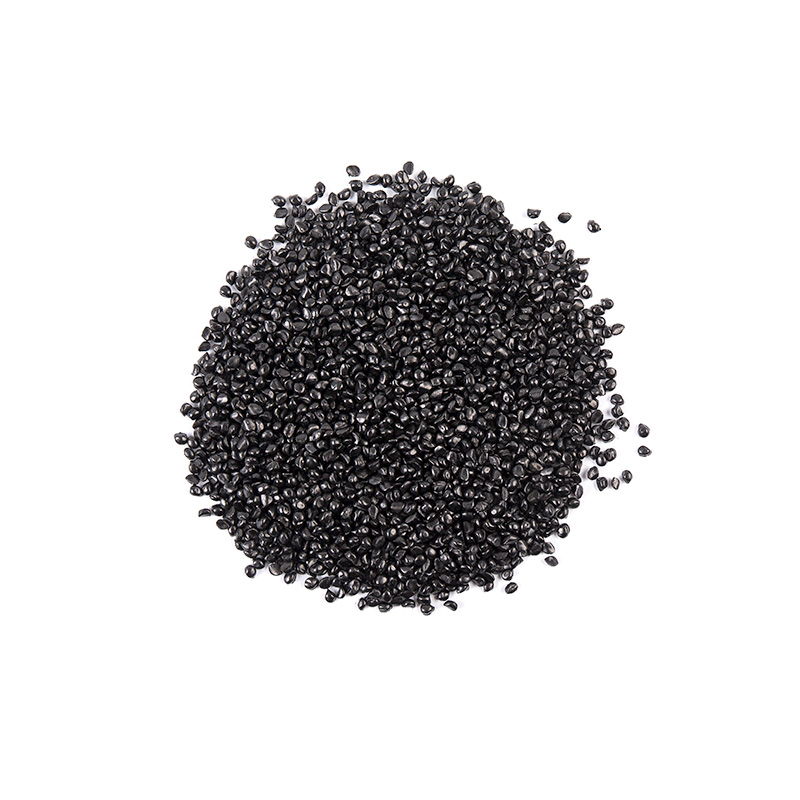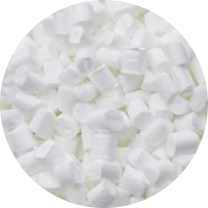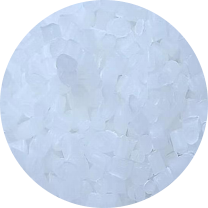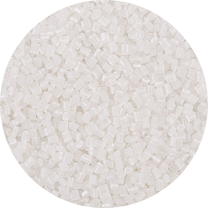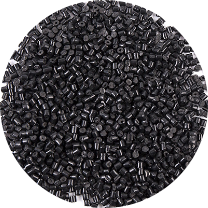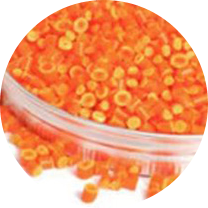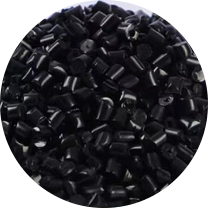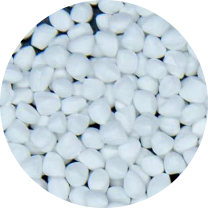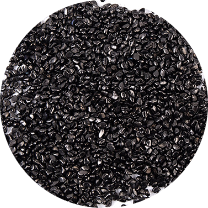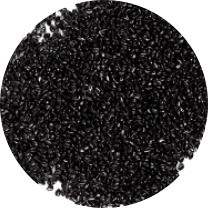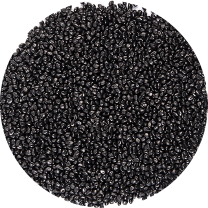Understanding Carbon Black Masterbatch: Applications, Benefits, and Production
1. Introduction to Carbon Black Masterbatch
What is it?
Carbon black masterbatch is a concentrated mixture of carbon black pigment dispersed into a polymer carrier resin. Essentially, it's a pre-mixed, pelletized form of carbon black that is much easier and safer to use than raw carbon black powder. The carrier resin is often a polymer compatible with the final product, such as polyethylene (PE), polypropylene (PP), or polystyrene (PS).
Why is it used?
This product is an essential component in the plastics and rubber industries. Its primary purpose is to impart a deep, rich black color to plastics, but it also serves several other critical functions. These include:
- UV Protection: Carbon black is highly effective at absorbing ultraviolet (UV) radiation, which can cause plastics to become brittle and degrade over time. By incorporating it into a product, the masterbatch significantly extends the plastic's lifespan, especially for outdoor applications.
- Enhancing Properties: Beyond coloring and UV protection, carbon black can improve a polymer's mechanical properties, such as its strength and stiffness. Special grades can also make plastics electrically conductive or anti-static.
- Ease of Use: Compared to handling messy, airborne carbon black powder, masterbatch pellets are clean, easy to measure, and simple to introduce into the manufacturing process. This improves workplace safety and efficiency.
Key components:
The performance of a masterbatch depends on the careful selection of its three main components:
| Component | Description |
| Carbon Black | The pigment itself. Different grades of carbon black offer varying levels of color intensity, UV protection, and conductivity. |
| Polymer Carrier | The resin in which the carbon black is dispersed. It must be compatible with the base polymer of the final product to ensure proper mixing and performance. |
| Additives | Various chemicals are added to improve the dispersion of the carbon black, enhance UV protection, or provide other specific properties like heat stability. |
2. Production Process of Carbon Black Masterbatch
Raw Material Preparation
This first step involves selecting the appropriate carbon black pigment and polymer carrier resin. The choice of materials is crucial and depends on the final application. For example, a masterbatch for electrical cables will use a different type of carbon black than one for a simple black plastic toy. The polymer carrier must also be compatible with the base polymer of the final product to ensure proper mixing and adhesion.
Mixing and Dispersion
This is the most critical stage. The carbon black pigment is mixed with the polymer carrier, along with any necessary additives. The goal is to break down the carbon black into its primary particles and disperse them uniformly throughout the polymer matrix. This is usually done using high-shear mixing equipment, such as:
| Equipment Type | Description | Key Advantage |
| Twin-Screw Extruder | A machine with two intermeshing screws that mix and melt the materials. | Provides excellent shear and dispersion, ideal for high-quality masterbatches. |
| Kneader | A specialized mixer that uses a kneading action to disperse the pigment. | Effective for high-viscosity materials and can handle high pigment concentrations. |
| Banbury Mixer | A batch mixer often used in the rubber industry. | Excellent for high-volume production, but dispersion quality can be lower than with extruders. |
The dispersion quality is measured by various factors, including the size and distribution of the carbon black aggregates within the polymer.
Extrusion and Granulation
Once the carbon black is properly dispersed, the molten mixture is extruded through a die to form continuous strands. These strands are then cooled and cut into small, uniform pellets. This pellet form is what makes the masterbatch so easy to handle and use in downstream manufacturing processes.
Quality Control
Before the masterbatch is packaged and shipped, it undergoes a series of rigorous quality control tests. These tests ensure the product meets specifications for:
- Dispersion quality: Visual and microscopic inspection to check for undispersed particles.
- Color consistency: Comparing the color of the masterbatch against a standard.
- Melt flow index: Measuring the flow properties of the material, which is important for processing.
- Moisture content: Ensuring the pellets are dry to prevent defects during molding.
By following this precise process, manufacturers can produce a high-quality carbon black masterbatch that delivers consistent color and performance.
3. Key Benefits of Using Carbon Black Masterbatch
Superior Dispersion
Achieving a uniform, streak-free black color in plastic products is a major challenge with raw pigment powder. Masterbatch pellets are produced using specialized high-shear mixing equipment, which ensures the carbon black is broken down and perfectly dispersed within the carrier resin. This eliminates the risk of "black specks" or uneven coloring in the final product.
| Feature | Carbon Black Masterbatch | Raw Carbon Black Powder |
| Dispersion Quality | Excellent, uniform dispersion due to high-shear mixing during production. | Poor, often leading to agglomerates, streaks, or spots in the final product. |
| Color Consistency | High consistency and repeatability, ensuring uniform color from batch to batch. | Can be inconsistent and difficult to reproduce exact color shades. |
UV Resistance
Carbon black is one of the most effective and economical UV stabilizers for plastics. When properly dispersed through a masterbatch, it creates a protective barrier that absorbs harmful UV radiation. This is crucial for products used outdoors, such as pipes, cables, and agricultural films, as it prevents them from becoming brittle, cracking, and losing their mechanical strength.
Cost-Effectiveness
While masterbatch pellets may have a higher initial cost per kilogram than raw powder, they lead to significant cost savings in the long run. By using a highly concentrated and well-dispersed masterbatch, manufacturers can reduce the amount of pigment needed, minimize waste, and shorten mixing times. The improved quality also reduces the number of rejected parts, further cutting costs.
Improved Handling and Safety
Carbon black powder is extremely fine, airborne, and difficult to handle. It can create a messy production environment and poses potential health risks for workers if inhaled. Masterbatch, in its pelletized form, is dust-free, easy to pour, and simple to handle. This not only makes the workplace cleaner and more efficient but also significantly improves safety.
Enhanced Electrical Properties
Certain grades of carbon black masterbatch are specifically formulated to impart electrical conductivity to plastics. This is essential for applications requiring anti-static properties, such as electronic packaging, or for products that need to dissipate static charges, like fuel tanks and certain types of pipes. The masterbatch ensures a consistent and reliable level of conductivity throughout the plastic part.
4. Applications of Carbon Black Masterbatch
Pipes and Fittings
The use of carbon black masterbatch is essential in the production of plastic pipes, especially for water and gas distribution systems. These pipes are often exposed to sunlight, and the masterbatch provides a crucial UV protective barrier that prevents the plastic from degrading and becoming brittle over time. This ensures the long-term integrity and reliability of the infrastructure.
Automotive Parts
In the automotive industry, carbon black masterbatch is used to produce a variety of interior and exterior components. It provides a deep black color to parts like bumpers, dashboards, and trims. Beyond aesthetics, it also offers UV stabilization, preventing discoloration and material degradation from sun exposure, which is critical for maintaining the appearance and functionality of a vehicle over its lifespan.
Agricultural Films
Agricultural films, such as those used for greenhouses and mulching, are constantly exposed to intense sunlight. Carbon black masterbatch is incorporated into these films to absorb UV radiation, which helps to extend their service life. This protection is vital for farmers, as it reduces the need for frequent replacement and maintains the films' structural integrity, thereby protecting crops.
Wires and Cables
For the sheathing of electrical wires and cables, carbon black masterbatch is used for its dual benefits of UV protection and electrical conductivity. The UV-blocking properties prevent the cable's outer layer from cracking and failing when exposed to sunlight. Additionally, certain types of carbon black can be used to make the sheathing semi-conductive, which is important for voltage stabilization in high-voltage cables.
Packaging
In the packaging industry, carbon black masterbatch is used for a variety of applications, from food containers to industrial drums. It provides an opaque black color that can protect light-sensitive contents. The masterbatch's ability to create a consistent and solid black color is also important for brand aesthetics and product presentation.
5. Future Trends and Innovations
Specialized Masterbatches for High-Tech Applications
As various industries raise their performance requirements for plastics, the demand for carbon black masterbatches is becoming increasingly refined. A future trend is the development of masterbatches specifically for high-tech applications. For example, in the field of non-woven fabrics, particularly melt-blown fabric, special masterbatches are required to produce filtration materials. These masterbatches not only provide color but, more importantly, ensure that the produced fabric has specific physical and chemical properties to meet the strict standards for masks or air filters.
Innovations in Enhanced Functionality
The function of masterbatches is evolving from a single coloring agent and UV stabilizer to a multifunctional additive. A significant innovative direction is the development of masterbatches with special functions, such as "electret masterbatches." These masterbatches enable plastic fibers to carry a lasting electrostatic charge during the production process. In filtration materials like melt-blown fabric, this electrostatic charge can significantly enhance the material's ability to adsorb tiny particles in the air (such as viruses, bacteria, and dust), thereby greatly improving filtration efficiency.
| Function Type | Traditional Carbon Black Masterbatch | Innovative Functional Masterbatch |
| Main Function | Coloring, UV protection | Imparts special functions like anti-static, conductive, or electret properties |
| Application Areas | General plastic products, pipes | High-performance filtration materials, electronic packaging |
| Core Value | Aesthetics and basic protection | Performance enhancement and application expansion |
Focus on Sustainable Production
With increasing global emphasis on environmental protection, the production of carbon black masterbatch is also paying more attention to energy conservation, consumption reduction, and environmental protection. Future trends will focus on optimizing production processes to reduce energy consumption and waste emissions. Companies will actively explore the use of more environmentally friendly additives and adopt advanced production equipment and processes to maximize production efficiency while minimizing environmental impact. For example, Changzhou Runyi New Material Technology Co., Ltd. emphasizes its goal of maximizing energy conservation, consumption reduction, and environmental protection in its production process, which reflects this industry trend.
Continuous R&D and Technology Upgrades
To meet ever-changing market demands, masterbatch manufacturers will continue to invest in R&D to develop new products and formulations. This includes, but is not limited to, exploring new carbon black grades, optimizing the molecular structure of masterbatches, and developing more efficient production equipment. Through continuous technological upgrades, the industry will be able to provide products with superior performance, a wider range of applications, and better environmental friendliness, thereby promoting the progress of the entire plastics industry.
PA-103 Multipurpose High Performance Stability Black Masterbatch
prevNo previous article
nextCarbon Black Masterbatch: A Comprehensive Analysis and Application Guide


 English
English 中文简体
中文简体 한국어
한국어 عربى
عربى